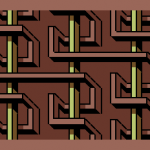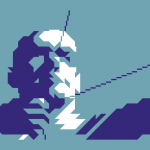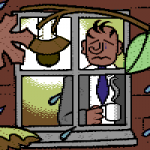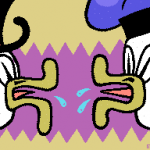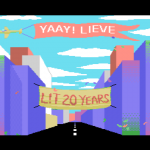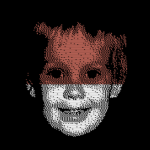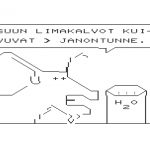Posts filed under 'demoskene'
Vuodesta 2014 alkaen järjestetty Graffathon on jossakin hackathonin ja demopartyn välimaastossa – paikan päällä värkkäily sekä ryhmäytyminen ovat pikemminkin hackathonia, kun taas demoihin keskittyminen ja kilpailullisuus viittaa enemmän jälkimmäiseen suuntaan (vaikka hackathoneissakin toki jaetaan palkintoja). Tarkoituksena on yhtäältä oppia reaaliaikaisen grafiikan ohjelmointia ja toisaalta tutustua – ainakin pintapuolisesti – demojen sekä demoskenen olemukseen. Olin kaavaillut Graffathonissa pistäytymistä jo pitkään, ja nyt kun pyysivät esitelmöimään demokulttuurista, niin sain lopulta myös vääntäydyttyä paikalle asti.
Paikalla oli jokunen vanha tuttu skenenaama, mutta pääosin osallistujat edustivat varsinaista kohderyhmää eli aloittelijoita. Startup sauna tarjosi tilaisuudelle normaaliin pikkupartyyn verrattuna massiiviset puitteet: runsaasti työtilaa, avokeittiön, av-laitteistoa ja isohkon luentotilan tuoleineen. Sponsorirahoilla oli kävijöille hankittu myös purtavaa ja juotavaa. Suurin ero normipartyyn oli ehkä kuitenkin porukan selväpäisyys ja salin hiljaisuus 🙂
Oma esitelmäni oli hiukan muokattu vakiopresikseni demoskenen käsitteistä ja historiasta. Sisältöä ja jaarittelua karsimalla sain sen jo melkein mahtumaan annettuun tuntiin, mikä ei ole tähän mennessä yleensä onnistunut. Sanottavaa oli sittenkin paljon, joten kaikenlaista piti ohittaa. Kuulijoiden (oletetusti) teknisen taustan vuoksi saatoin kertoa teknisemmistäkin detskuista, joista en humanisteille tai taideopiskelijoille juuri puhu. Kai se hyvin meni, jossain vaiheessa tullee videokin johonkin näkyville.
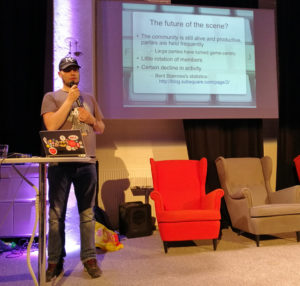
Skenen tulevaisuus. Kuvan näppäsi Claustro.
edit: vidska täällä: https://www.youtube.com/watch?v=UJ6A56ZB7Uo
edit2: kuulin juuri aika mielenkiintoista palautetta luennosta (useimmat olivat siitä pitäneet, paitsi tämä kriitikko):
- En innostanut yleisöä tekemään demoja
- Näytin liikaa vanhoja 2D-demoja enkä uusimpia 3D-tuotoksia
- Näytin demoja liian kauan, palautteen mukaan 20 sekuntia on yläraja
- Demojen etsiminenkin kesti kuulemma liian kauan(!)
- Vitsailin alussa, että luultavasti menen yliajalle, mutta sekin oli väärin. Ei saa mennä viittäkään minuuttia yliajalle kuulemma (vaikka kyseessä on harrastajavoimin pyörivä epävirallinen tapaaminen).
- Menin yleisön joukkoon istumaan, kun demot olivat pyörimässä. Sekin väärin.
- Annoin ikävää kuvaa demopartyistä
- Julkesin mainita, että demonteko on ollut pääosin miehinen harrastus
- Boy-demon viestikin näytti menneen ohi ja se oli otettu kirjaimellisesti eikä karrikoituna kommentaarina
- Demoskenen kuoleman ennusteluistakaan ei olisi saanut puhua
Mahdotonhan se on kaikkia miellyttää, mutta näin digitaalisen kulttuurin tutkijana tarkoituksenani – ja velvollisuutenani – oli realistisen kuvan antaminen skenestä pikemminkin kuin mikään hurmehenkinen pitchaus, jota tämä kuulija oli ilmeisesti odottanut.
July 1st, 2017
Teron kanssa pitkään ja hartaasti väännetty WiderScreenin tekstitaideteemanumero saatiin lopultakin uunista ulos. Toimitustyöt osoittautuivat odottamattoman raskaiksi tällä kertaa, eikä ajoituskaan ollut kovin optimaalinen, kiitos lukuisten väittelyyn liittyneiden prosessien. Toivottavasti lopputulos on lukijoille kuitenkin viihdyttävä ja valaiseva. Kirjoitimme itsekin pikku katsauksen – tiettävästi – ensimmäisestä Suomessa julkaistusta tietokonesarjakuvasta sekä siitä tekemästämme uusioversiosta. Kuulin juuri myös, että porilaisten kanssa tehty konferenssipapru suomalaisista pelikilpailuista oli tullut juuri linjoille. Julkaisuhuuman täydentää lähipäivinä ilmestyvä Tekniikan Waiheita, jossa julkaistaan lektioni.

ROCK JOKA TIESI… LIIKAA!
edit: kah, tuli vielä tämäkin Pac-Man-papru pihalle.
June 15th, 2017
Kokoelmissani oleva, nimimerkki Tundrahin alkujaan omistama Commodore 64 “Aldi” sai toimia useissa PR-tarkoituksissa tänä keväänä. Kyseessähän on siis ainoastaan Saksassa myyty halpahalli-nepa, joka oli jotain kautta kulkeentunut Suomeen: germaaneille ei mikään harvinaisuus, mutta muualla vähemmän nähty. “Aldi” ei ole virallinen tyyppinimi ja mallia myytiin muissakin kaupoissa, mutta nimi on vakiintunut harrastajien parissa. Mikään muu C-64 ei näytä aivan samalta, koska kyseisessä koneessa on vanhan leipälaatikon ruskea kuori, mutta kuitenkin 64C:n vaalea näppis, jossa grafiikkamerkit ovat sivussa (samalta näyttäviä on tavattu kahdesta koneesta itse yhdisteltyinäkin, mutta Aldissa on hopeatarra kyljessä ja pohjassa lukee “MADE IN USA”). Sisuksissa on tavanomainen lyhyt emolevy. Tämä kyseinen yksilö ei ole pelkkä koriste, vaan palvelee pääasiallisena demo/pelikoneenani hyvin toimivan näppiksen, 8580:n ja näppärän kokonsa vuoksi.
-
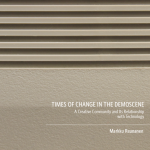
-
Väikkärin kansi
-
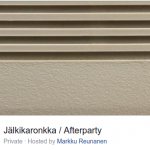
-
Jälkikaronkan kutsu
-

-
Väitöstiedotekuva
-
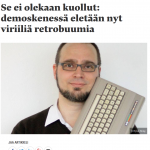
-
TiVin artikkelista
April 4th, 2017
Pitkään valmisteltu pikku konferenssimme, Home Computer Subcultures and Society Before the Internet Age, saatiin kunnialla päätökseen viime viikonloppuna Zürichissä. Heiluin mukana järjestelyissä sen verran kuin pystyin, mutta suurin osa käytännön työstä jäi kuitenkin Glebin niskoille. Ohjelma oli sikäli tiukka aamusta iltaan kahtena päivänä, että turismille ei jäänyt ollenkaan aikaa. Mäkiä ja portaita tuli ainakin nähtyä, jos ei paljon muuta. Tapahtumapaikka oli arvoisa vanha tähtitorni, Collegium Helveticum, joka tarjosi komeat, jos sitten teknisesti jokseenkin vanhahtavat puitteet.
Koskaan aiemmin ei ole tuntunut näin paljon siltä, että nyt olen oikeassa konffassa. Paikalle oli saatu – kiitos SNF:n ja ZZF:n myöntämän rahoituksen – varsin kansainvälinen tutkijaporukka, jonka aiheet olivat hyvin lähellä omiani: demoja, piraatteja, peliteollisuuden historiaa, purkkikulttuuria ja paikallista tietotekniikan historiaa mm. Puolasta ja Tsekkoslovakiasta. Kirjoista, lehdistä ja sähköposteista tuttuja nimiä, jotka muuttuivat näin oikeiksi ihmisiksi. Vaikka verkostoituminen onkin hieman kulahtanut bisnestermi, niin uskon kolleegion kesken syntyneen uusia hyödyllisiä yhteyksiä, jotka johtavat myöhemmin konkreettiseen yhteistyöhön. Perjantai-illalla oli virallisen ohjelman lisäksi Konstantin Stürzin kräkkeriaiheisen lyhytelokuvan ensiesitys.
Oma esitykseni käsitteli metatasolla sitä, ketkä ovat tehneet demo- ja kräkkeritutkimusta. Printtasin kotona Demoscene Researchin bibliografian, leikkasin paperin paloiksi ja tein lappusille erilaisia ryhmittelyjä. En ole lopputulokseen loputtoman tyytyväinen, mutta olipa edes jotain tuoretta esitettävää, jota saatan myöhemmin tunkata julkaistavaksikin asti. Presiksen lisäksi olin kahden paneelin puheenjohtajana – uusi kokemus sekin, vaikka muistuttaakin vahvasti opiskelijoiden kurssiesitysten kommentointia ja aikataulussa pitämistä. Paneelikeskustelu oli eloisaa ja aika loppui aina kesken, mikä oli varsin hyvä merkki aiheiden kiinnostavuudesta. Perjantaihin ajoittui vielä ylimääräisenä bonuksena tohtorintutkintoni hyväksyminen, vaikka kuulinkin siitä itse vasta muutaman päivän päästä.
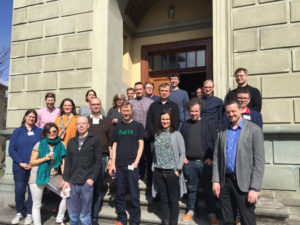
Kuva: Esther Laurencikova
March 30th, 2017
Flunssasta huolimatta sain eilen hoidettua pois tohtorintutkinnon viimeisen etapin, kun puolustin väitöskirjaani Porin yliopistokeskuksessa. Tilaisuus oli pieni ja kotoisa, eikä vastaväittäjä, Carl Therrien, heittäytynyt häijyksi, mutta onneksi haastetta hiukan lisäsi päällä jyllittävä nuha, jota koitin lääkitä Ibumaxin ja Mynthonin keinoin. Kokoversio väikkäristäni, Times of Change in the Demoscene: A Creative Community and Its Relationship with Technology, on nyt ladattavissa linkin takaa – yliopiston sivuilla olevasta puuttuvat itse artikkelit. Idakin osallistui:
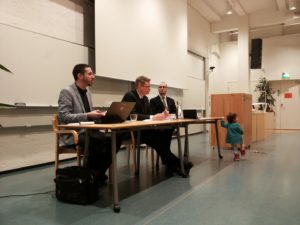
February 18th, 2017
I’ve been using various guesstimates throughout the years for the PAL MSX screen and pixel aspect ratios, but now there’s finally something credible instead (in contrast, NTSC machines have ~square pixels). According to this discussion thread, the pixels are as wide as 7:5 or, in other words, they are 1.4 times as wide as they are high. That’s pretty flat! I got almost same figures on my own Philips 1084S using a ruler, so they’re very likely correct. Other calculations:
- The pixel area of a 256×192 image is 5.6:3 — almost the same as a modern 16:9 screen
- That is a multiplier of 1.8666… for the image height to calculate the width
- In terms of square pixels 358×192 is very close, or with double pixels 717×384 even better
Viewing a borderless SCREEN 2 image fullscreen on a 16:9 screen gives a pretty good quick estimate of how it will look like. Two things to note are of course that people’s CRT displays are not perfectly calibrated, and that emulators do not use a correct ratio by default. In general horizontal stretching looks worse than vertical, which might be one reason emulators are a bit conservative with their aspect ratios; for example openMSX definitely produces a narrow image – even setting horizontal_stretch to its minimum value of 256 doesn’t make the image flat enough. Furthermore, Japanese Konami warez would appear unnaturally squeezed, even though that’s exactly how they were seen in Europe back in the day.
Square pixels vs. a corrected image:
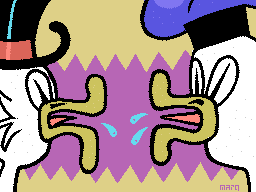
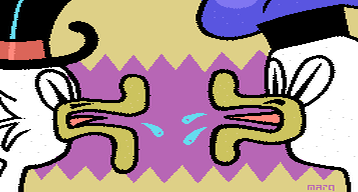
edit: just as notes here some other numbers. Out of a 313 line full progressive PAL frame about 61.3% is spent on actual pixel lines, while the remaining 121 lines (38.7%) are for the border (113 lines) and vertical sync (8 lines). Dividing 3.58 MHz by 50 yields 71600 clocks per frame, but as a progressive frame is longer (49.92 Hz), the actual clocks are closer to 71700 per frame or 229 per scanline.
As shown by the IO demo, the exact cycles are not stable across machines, which makes it tricky to do splitting effects on an MSX1. IO uses a timing of 228 cycles/line or 71364 per frame, so those are probably the correct numbers on at least some machines.
edit2: Haven’t confirmed yet whether the MSX outputs 312 or 313 lines per frame, so the figures above are just estimates (there are some other possible error sources too). What is known is that the vertical blanking interrupt (VBI) takes place immediately after the last pixel line, not outside the screen. In addition, ideal Z80 cycles are not correct on real machines, as there are additional T-states introduced by memory access.
August 1st, 2016
Homma on edennyt niin hitaasti ja kankeasti, etten ole kovin paljon kenellekään viitsinyt mainostaa tekeväni taas yhtä opinnäytettä. Nyt, kun kirjoitusurakka alkaa kääntyä loppusuoralle (ensimmäinen raakaversio tuli valmiiksi juuri tänään) niin uskaltanen jo kertoa, että väitöskirja on tarkoitus taputella kuntoon vielä tämän vuoden puolella, sikäli kun ohjaajat, esitarkastajat ja laitoksen moninaiset prosessit sen sallivat. Aiheena jälleen sama kuin lisurissakin eli demoskene, mutta tällä kertaa paremmassa ohjauksessa sekä jo hieman kouliintuneemman humanistin ottein. Turun yliopiston digitaalisen kulttuurin oppiainehan on humanistisen tiedekunnan alla — tätä tilannetta tuskin olisin 1996 kuvitellut näkeväni.
Näin jälkiviisautena tohtorintutkintoon olisi voinut ja kannattanut tähdätä hieman suorempaa polkua. Toisen maisterintutkinnon tekemisestä on ollut käytännössä aika marginaalisesti hyötyä, eivätkä lisensiaatin paperitkaan oikein avanneet uusia ovia nykyisen akateemisen maailman tohtori/ei tohtori -binäärin vuoksi. Noh, kaipa noista opinnoista on edes jotain syvämmen sivistystä tarttunut. Jos voisin nyt neuvoa 2009 itseäni, niin: häivy sen lisurisi kanssa vehreämmille laitumille ja laajenna se siellä monografiaväikkäriksi kunnon ohjauksessa. Moisella oikopolulla olisi säästynyt muutama vuosi.
Olen välillä ollut pikkiriikkisen kateellinen jatko-opiskelijakollegoilleni, sillä he ovat enemmän ja vähemmän kaikki jostain humanistiselta alalta peräisin. Itse taas olen aika kotikutoinen tapaus, sillä en ole maisterivaiheessa koskaan tutustunut humanistisiin tutkimusmenetelmiin, diskursseihin jne., jollei sitten paria taidehistorian peruskurssia lasketa. Asiat voi toki opetella omin nokkineenkin, mutta hieman turhauttavaa ja epävarmaa se on toisinaan ollut toisenlaisesta taustasta tulevalle. En edelleenkään pärjää Foucault/Deleuze/Latour-vyörytyksessä, mutta tutkimusta voi onneksi tehdä maanläheisemminkin.
June 24th, 2016
During the last few days I’ve spent hours and hours trying to understand how Oric (Oric-1 and Atmos) hires graphics work. Compared to most 8-bit home computers of the 1980s the mode is notably different with its “serial attribute” based layout. If you know how teletext works, you’ll easily notice certain similarities. You can find multiple elaborate explanations of Oric graphics online, but I’ll try and distill their essence into a few minimalistic rules:
- There are 240 by 200 pixels described by 8000 bytes located at A000h (followed by three hard-wired lines of text which we will omit). One row is 40 bytes.
- There are eight colors to choose from: black, red, green, yellow, blue, magenta, cyan and white ie. a typical 3-bit BGR colorspace from 0 to 7.
- For each byte – describing six not eight pixels – you can do one of the following:
- Change the ink color. Six pixels of paper color will be displayed in this 6×1 block. Byte contents: 0..7.
- Change the paper color. Six pixels of the new paper color will be displayed. Byte contents: 16..23.
- Display pixels using the current ink (1) and paper color (0). Byte contents: 40h + bitmap in the lower-order bits.
- If bit 7 is on, the block will be displayed in inverted colors. Note that the inversion does not affect the result of ink/paper change operations, only the outlook of the 6×1 block. The inversion logic is a bitwise not:
- black – white, 000 – 111
- red – cyan, 001 – 110
- green – magenta, 010 – 101
- yellow – blue, 011 – 100
- Every new row starts with white ink and black paper.
In addition there’s stuff like 50/60 Hz, blinking and text mode setting, but we’ll skip them too. At first the ruleset seems quite simple, but once you actually start thinking of how to do graphics with it, things don’t look that easy anymore. Let’s warm up with a little close-up of a real Oric piccy (“Yessagician” by Dbug):
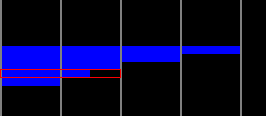
This is the left edge of the screen and the gray lines denote 6 pixel block borders. How would you choose the operations for displaying the pixels – in particular the area I’ve outlined with a red rectangle?
Solutions: the completely black lines we could show as pixels as the line starts with white ink and black paper, but there’s many other possible solutions too. Every black 6×1 block might actually contain an ink change or perhaps setting the paper to black again. Or setting the paper to white and turning the inverse bit on. The 6×1 blue blocks we could create by simply changing the paper to blue, after which the next identical block could contain an optional ink change.
As to the marked area, however, we need to do something else. Changing the paper to blue on the left leaves us with white/blue which will not do for the next block as there are pixels to be displayed. The only possible solution is to turn paper yellow and invert the colors for both of the blocks. An inverted white/yellow pair provides the needed black/blue for the bitmap.
The first two questions I tried to solve were “Is this picture a legal Oric hires image?” and “How to display a legal image using the possible operations?” There’s more to converting a random image to the Oric, but these two problems have to be understood in order to get anywhere. A first bruteforce solution which didn’t even check all the possible combinations took several minutes to solve just one row of a simple image on a recent i5 computer, so clearly something else had to be done.
For each 6×1 block containing one or two colors there can be multiple solutions. Two-color blocks are the easy case: there’s the bitmap and the colors inherited from the left, possibly inverted. One-color blocks are a different ballgame altogether, since they can contain paper changes, invisible ink changes or they might even be a bitmap. All of this with or without inversion, of course. Another difference is that a two-color block needs to get proper colors from the left, whereas a single-color one can be displayed anytime with a paper change.
The following image tries to convey a conceptual model of how it works:
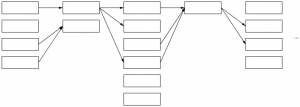
Each column in the graph represents a 6×1 block and its multiple possible solutions. Some could call this a directed acyclic graph. The first block can be displayed in four different ways, the next only in two and so on – in reality the numbers are a lot higher with singe-color blocks. The arrows denote possible movement from left to right: each way of displaying a given block here limits the options for the next block. For example a block which leaves ink/paper as white/black does not provide for its neighbor in need of red color.
Instead of a recursive approach starting from the left and trying out all the possible solutions it is enough to simply loop through the columns, create the links, optionally dropping the dead-ends (solutions leading nowhere on the right or with no supply from the left) and duplicates (same in/out combinations). If there is a path that runs all the way from the left edge to the right, we can conclude that this particular row is legal. More than one path is possible, but that doesn’t really matter. Walking back from right to left we can collect one legit representation for the row, thus solving the two “research questions”.
When it comes to dealing with images that do not comply or converting a random jpeg, I don’t have much to say yet. Different approaches will lead to better or worse approximations – as of now I simply turn offending two-color blocks to single-color ones, but much more could be done. Further reading and examples here:
edit: some first thoughs on dealing with non-conforming images. The first thing I’d try is make a graph with approximate solutions, make the errors the weights of the vertices and use a shortest path algorithm such as Dijkstra’s to find the nearest possible approximation.
edit2: here’s a bit more visual representation of the bits as a bonus.
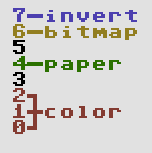
May 26th, 2016
A project I’ve been working on for the last few weeks is now out: Pixel Polizei is a helper tool for the retro artist. The purpose is to let the “graphician” draw using whatever software they happen to like, check/force color clashes and finally save the outcome in native formats that can be viewed using emulators or the real deal. So far there is support for these machines and screen modes:
- Amstrad CPC modes 0 and 1 with or without overscan
- C-64 hires and multicolor
- MSX screen 2
- Oric hires
- Plus/4 hires and multicolor
- ZX Spectrum
More formats and platforms will appear when I find the time and motivation again. As usual, the tool should work on Lin/Mac/Win as long as Java 7 or newer is installed. Open source, too.
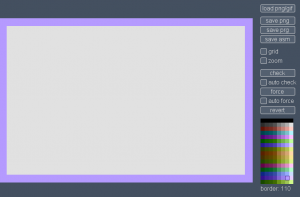
May 17th, 2016
Next Posts
Previous Posts










